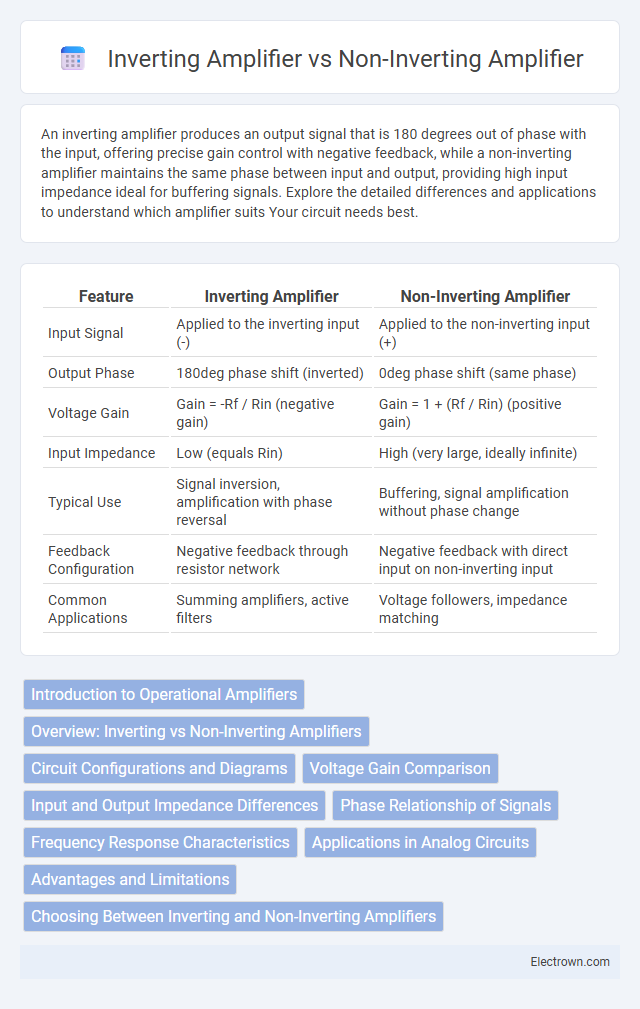An inverting amplifier produces an output signal that is 180 degrees out of phase with the input, offering precise gain control with negative feedback, while a non-inverting amplifier maintains the same phase between input and output, providing high input impedance ideal for buffering signals. Explore the detailed differences and applications to understand which amplifier suits Your circuit needs best.
Table of Comparison
| Feature | Inverting Amplifier | Non-Inverting Amplifier |
|---|---|---|
| Input Signal | Applied to the inverting input (-) | Applied to the non-inverting input (+) |
| Output Phase | 180deg phase shift (inverted) | 0deg phase shift (same phase) |
| Voltage Gain | Gain = -Rf / Rin (negative gain) | Gain = 1 + (Rf / Rin) (positive gain) |
| Input Impedance | Low (equals Rin) | High (very large, ideally infinite) |
| Typical Use | Signal inversion, amplification with phase reversal | Buffering, signal amplification without phase change |
| Feedback Configuration | Negative feedback through resistor network | Negative feedback with direct input on non-inverting input |
| Common Applications | Summing amplifiers, active filters | Voltage followers, impedance matching |
Introduction to Operational Amplifiers
Operational amplifiers (op-amps) are versatile electronic components widely used in signal processing. An inverting amplifier configuration provides a 180-degree phase shift of the input signal with adjustable gain determined by resistor ratios. The non-inverting amplifier, by contrast, maintains the input signal phase while offering gain control and high input impedance, making it ideal for buffering Your signals without loading the source.
Overview: Inverting vs Non-Inverting Amplifiers
Inverting amplifiers provide a phase shift of 180 degrees between input and output signals, offering high gain with an input signal connected to the inverting terminal. Non-inverting amplifiers maintain the same phase as the input, delivering high input impedance and lower noise levels, making them ideal for buffering applications. Your choice depends on signal phase requirements and input impedance considerations in electronic circuit design.
Circuit Configurations and Diagrams
Inverting amplifiers use an input signal applied to the inverting terminal of the operational amplifier, with the non-inverting terminal grounded, creating a circuit where the output voltage is 180 degrees out of phase with the input. Non-inverting amplifiers apply the input signal directly to the non-inverting terminal, while the inverting terminal is connected to the output through a feedback resistor, resulting in a positive phase gain. Your choice between these configurations depends on the desired signal phase and gain characteristics, which can be clearly understood by studying their respective circuit diagrams.
Voltage Gain Comparison
Inverting amplifiers offer a voltage gain equal to the ratio of the feedback resistor to the input resistor, with the output signal inverted in phase by 180 degrees. Non-inverting amplifiers provide a voltage gain of one plus the ratio of the feedback resistor to the input resistor, delivering an output signal in phase with the input. Voltage gain in non-inverting amplifiers is always greater than or equal to one, while inverting amplifiers can have gains less than one, enabling more flexible gain control.
Input and Output Impedance Differences
Inverting amplifiers typically have low input impedance due to the input signal being applied directly to the inverting terminal through a resistor, which can load your signal source. Non-inverting amplifiers offer high input impedance since the input signal is applied to the non-inverting terminal, making them ideal for buffering high-impedance sources. Output impedance remains low in both configurations, ensuring effective signal driving capability to the load.
Phase Relationship of Signals
An inverting amplifier produces an output signal that is 180 degrees out of phase with the input signal, causing the waveform to be flipped upside down. In contrast, a non-inverting amplifier maintains the same phase as the input, delivering an output signal that is in phase with your original input voltage. Understanding these phase relationships is essential when designing circuits requiring specific signal alignment or phase-sensitive feedback loops.
Frequency Response Characteristics
Inverting amplifiers typically exhibit slightly reduced bandwidth compared to non-inverting amplifiers due to their feedback configuration, which influences gain-bandwidth product limitations. Non-inverting amplifiers maintain higher input impedance and generally provide better frequency response with less phase shift, making them suitable for high-frequency applications. Your choice should consider the trade-off between input impedance and frequency behavior to optimize amplifier performance in specific circuit designs.
Applications in Analog Circuits
Inverting amplifiers excel in signal conditioning applications requiring phase inversion and precise gain control, such as audio mixers and active filters. Non-inverting amplifiers are preferred in buffer circuits, sensor signal amplification, and voltage followers due to their high input impedance and unity gain stability. Both configurations play critical roles in analog circuits by optimizing signal fidelity and impedance matching across diverse electronic systems.
Advantages and Limitations
Inverting amplifiers offer precise phase inversion and high input impedance with excellent linearity, making them ideal for summing and differential applications. Non-inverting amplifiers provide high input impedance and unity gain stability, ensuring minimal signal distortion and ease of signal buffering. Limitations of inverting amplifiers include potential input offset errors and reduced input impedance, while non-inverting amplifiers may suffer from limited gain bandwidth and susceptibility to noise in high-gain configurations.
Choosing Between Inverting and Non-Inverting Amplifiers
Inverting amplifiers provide precise phase inversion and high linearity, making them ideal for signal processing applications requiring phase shift. Non-inverting amplifiers offer high input impedance and unity gain stability, best suited for buffering and impedance matching. Selecting between them depends on the need for signal phase inversion versus maximum input impedance and gain accuracy.
inverting amplifier vs non-inverting amplifier Infographic

 electrown.com
electrown.com